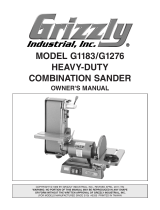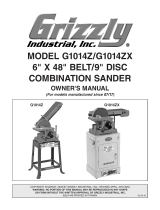G5049Z Combination Sander -15-
The following pages contain general machine
specifications, parts diagram and list and
Warranty/Return information for your Model
G5049Z Combination Sander.
If you need parts or help in assembling your
machine, or if you need operational information,
we encourage you to call our Service
Department. Our trained service technicians will
be glad to help you.
If you have comments or concerns dealing specif-
ically with this manual, please write to our
Bellingham, Washington location using the
address in the Introduction. The specifications,
drawings, and photographs illustrated in this
manual represent the Model G5049Z as supplied
when the manual was prepared. However, due to
Grizzly’s policy of continuous improvement,
changes may be made at any time with no oblig-
ation on the part of Grizzly. Whenever possible,
though, we send manual updates to all owners of
a particular tool or machine. Should you receive
one, add the new information to this manual and
keep it for reference.
The information in this manual has been obtained
from sources we believe to be reliable and as up-
to-date as possible. We have included some
important safety measures which are essential to
this machine’s operation. While most safety mea-
sures are generally universal, Grizzly reminds
you that each workshop is different and safety
rules should be considered as they apply to your
specific situation.
We recommend you keep a copy of our current
catalog for complete information regarding
Grizzly's warranty and return policy. If you need
additional technical information relating to this
machine, or if you need general assistance or
replacement parts, please contact the Service
Department listed in the introduction.
Additional information sources are necessary to
realize the full potential of this machine. Trade
journals, woodworking magazines, and your local
library are good places to start.
WARNING!
Like all power tools, there is danger associated
with the Model G5049Z Combination Sander.
Use the tool with respect and caution to lessen
the possibility of mechanical damage or operator
injury. If normal safety precautions are over-
looked or ignored, injury to the operator or others
in the area is likely.
The Model G5049Z was specifically designed for
sanding operations. DO NOT MODIFY AND/OR
USE THIS SANDER FOR ANY OTHER PUR-
POSE. Modifications or improper use of this
tool will void the warranty. If you are confused
about any aspect of this machine, DO NOT use it
until all your questions have been answered.
SECTION 8: CLOSURE






















